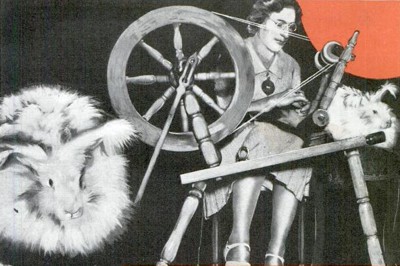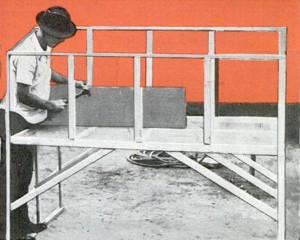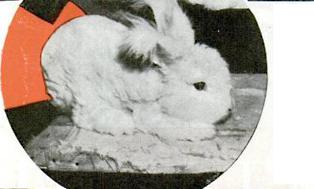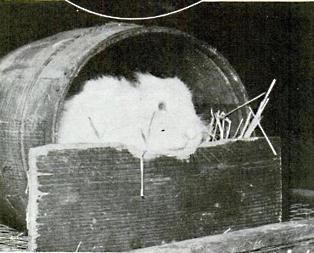Golden Fleece in your Back Yard
Here is an article about Angora Rabbits from the April 1940 issue of Popular Mechanics. While some of the advice it offers may have been valid in 1940, I would not advise following it today! (Angora rabbits are not going to make you rich.)
 |
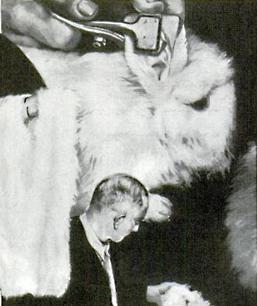 |
||||||||
|
At upper left, the start and finish-an angora rabbit ready for shearing and sweater knitted of homespun angora wool. Right: marking ear with indelible ink for identification, and (below) shearing wool. |
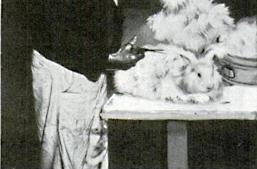 |
||||||||
|
|||||||||
Would you like to raise wool in your back yard, and go into the business of producing the “softest thing on earth”— for a good profit? You can, and you don’t need more than fifty dollars to start in America’s newest animal industry. The animal is the Angora rabbit, that animated fur ball which produces the wool for angora sweaters, mittens, jackets, and a hundred other warm and attractive garments. Tests have shown angora wool is not only the softest thing on earth, but also the warmest of animal fibers. In 1933 a California rancher spent his last thirty-five dollars for a pair of angoras and the construction of a hutch and shearing stand. This year his rabbitry was one of the largest in America with more than 1,000 rabbits. His monthly profit during 1939 was $200.
Until seven years ago, all angora wool was imported from England and France to be spun and woven in American mills. But in 1934 American-raised angora began to replace foreign wool. Starting originally on the west coast, angora raising has now spread to almost every state. Cold weather doesn’t bother angora rabbits, as the wool is just as warm on them as it is on humans.
Recently devised methods of spinning the yarn and weaving the garments have eliminated the problem of “shedding” or rubbing off of fuzz. The result has been an immense increase in the demand for angora goods. America consumed $84,000 worth of angora wool in 1934, $800,000 worth in 1938. Moreover, the revival of interest in knitting has increased the sale of angora yarn many times.
Starting with a good breeding doe rabbit and a buck of good ancestry, a back yard rabbitry should have a herd of fifty rabbits within a year. A good doe should cost about fifteen dollars, a buck ten dollars. Rabbits are weaned seven to eight weeks after birth. At that time they are given their first shearing. This, however, produces only a small amount of wool. The first good crop of wool is sheared three months after weaning, or four and a half to five months after birth. Rabbits are sheared every three months during their mature lifetime, which averages five years. A good angora, doe or buck, will produce a pound of wool a year. At present, unspun wool brings from three to five dollars a pound at the mill. Angora growers can also spin their wool into yarn. Although angoras are grown essentially for wool, they also make excellent eating. Therefore, bucks not needed for breeding, or rabbits whose wool production is below standard, may be sold for meat. Full-grown rabbits re-quire separate compartments in the hutches; however, until rabbits reach breeding age, two or three may be kept in the same compartment. Hutches may be built in tiers, but a single-tier hutch has several advantages. It is easy to reach, no trough is needed under the floor mesh to catch droppings, and it is easy to transport about the rabbit ry. Compartments for wool-bearing rabbits should be at least two by two feet; breeding compartments, two by four. A removable partition between compartments allows them to be converted easily into breeding compartments. Frames for the hutches should be of two-by-two inch or heavier stock, the sides being poultry netting. As the rabbits have a habit of chewing the wire, it has been found advantageous to use galvanized iron sheeting to a height of one foot on the sides and back. The floor should be of five- eighths-inch hardware cloth or three-fourths-inch wire netting. The roofs, hinged to allow access, should be of wallboard or similar material, covered with tar paper. Leaking roofs are dangerous, as the
Angoras are prone to catch cold in damp hutches. A hutch can be built with any number of compartments. Four is a convenient number. When built on a double plan, with compartments on both sides of a galvanized-iron center partition, this makes a unit of eight wool rabbit compartments, four breeding compartments, or any combination of the two. In mild climates rabbits may be left out of doors the year around, pro- vided the hutches are protected from rain. In cold climates it is necessary to have sheltered hutches for animals freshly sheared. Rabbits are successfully raised in Canada. Rabbits should be fed once a day. Feeding trays can be made from galvanized iron. To provide a water supply, a six-inch crock should be placed beside the feeding tray, held in place by clips or cleats to prevent the rabbit from moving or overturning it.
The principal diet of angoras should consist of alfalfa or clover hay and grain, or commercially prepared pellets embodying these ingredients. Rolled barley, oats and wheat are good grains for rabbit feeding. Angoras eat about half as much as ordinary meat rabbits. An average angora should consume one and one-half to two ounces of hay and one-half to one ounce of grain daily. They may also be fed such greens as carrots, kale, and green grass. However, care should be taken not to feed green foods in excess, and not too much should be fed at one time. Experience has shown that the feed bill per rabbit per year should not exceed S1.25, and on the average should be around a dollar.
For clipping rabbits, use an ordinary pair of sharp barber shears with good points, a small wire pet brush, and a wooden stand about four feet high. The top of the stand should be covered with coarse canvas to give the rabbit a better grip for its claws. First brush the rabbit well, then part the wool down the back. Shearing is done from the rump forward, line after line. The wool is graded as it is sheared and tossed into containers. After the back of the animal is sheared, the abdomen is clipped. Wool should be left on the abdomen of breeding does. Feet and heads are never sheared.
There are five grades of wool. Number one wool must average two and one-half inches in length and be absolutely clean and free from mats. Number two must be from one to two inches in length, clean and free from mats and shorts. Number three is the same as one and two, except that it is under one inch in length. Grade four is short, clean, but matted wool. Grade five is dirty or stained wool. The wool may be stored for any length of time, provided some mothproofing agent is used such as naphthalene flakes or crystals. When ready to be shipped, the wool should be placed in cloth or paper sacks (clean flour sacks will do) and each sack should be labeled with the grade and weight of wool The sacks should be packed in a strong cardboard carton and expressed to the mill or marketing cooperative. In- formation as to your nearest market and where good br eeding stock can be obtained may be had by writing the U.S. Department of Agriculture. The best wool producers should always be kept as breeders. It is inadvisable to cross breed the French and English strains. Although wool from the French angora commands a better price than the English, French type breeding stock is more expensive. Records should be kept on cards as to the productivity of each rabbit. Such records should give the weight of the rabbit before shearing, the weight after shearing, and the quality of the wool. For identification rabbits should be earmarked. This is done with indelible ink and a small instrument which stamps a number into the rabbit’s ear, or with a tattoo needle. For breeding purposes a nest box should be placed in the breeding compartment. A small nail keg will do excellently. Some clean straw should be thrown into the breeding hutch.
Angoras suffer from few diseases. A herd can almost always be kept healthy by observing a few simple precautions. The hutches should be placed where they get plenty of sunlight, but shaded during excessively hot weather. They should be kept clean and dry. Angora wool may be home spun with an ordinary spinning wheel. It has a great ad- vantage for home spinning since it need not be scoured or carded, being spun exactly as it comes from the animal. Although angora raising is a profitable business in itself, it has a vast field as a clean, simple, and pleasant way of producing additional income in your own back yard—a modern golden fleece.
